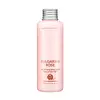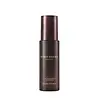What's inside
What's inside
 Key Ingredients
Key Ingredients

 Benefits
Benefits

 Concerns
Concerns

 Ingredients Side-by-side
Ingredients Side-by-side

Dipropylene Glycol
HumectantEthylhexyl Palmitate
EmollientButylene Glycol
HumectantHydrogenated Polydecene
EmollientCetyl Ethylhexanoate
EmollientCyclopentasiloxane
EmollientGlyceryl Stearate
EmollientPEG-100 Stearate
Butyrospermum Parkii Butter
Skin ConditioningDimethiconol
EmollientWater
Skin ConditioningRosa Damascena Flower Water
MaskingPhenoxyethanol
PreservativeHelianthus Annuus Seed Oil
EmollientRosa Hybrid Flower Extract
Skin ConditioningLilium Tigrinum Extract
Skin ConditioningIpomoea Purpurea Extract
Skin ConditioningCentaurea Cyanus Flower Extract
AstringentBorago Officinalis Extract
EmollientViola Mandshurica Flower Extract
AntioxidantSyringa Vulgaris Extract
Skin ConditioningCamellia Japonica Flower Extract
EmollientChrysanthemum Sinense Flower Extract
CleansingHelianthus Annuus Flower Extract
Skin ConditioningNarcissus Pseudo-Narcissus Flower Extract
Skin ConditioningPrunus Serrulata Flower Extract
Skin ConditioningPrunus Armeniaca Fruit Extract
Skin ConditioningNelumbo Nucifera Flower Extract
Skin Conditioning1,2-Hexanediol
Skin ConditioningGlycerin
HumectantAloe Barbadensis Leaf Extract
EmollientSodium Lactate
BufferingSodium Gluconate
Skin ConditioningPolysorbate 60
EmulsifyingSodium Hyaluronate
HumectantCetearyl Alcohol
EmollientSorbitan Sesquioleate
EmulsifyingStearic Acid
CleansingAcrylates/C10-30 Alkyl Acrylate Crosspolymer
Emulsion StabilisingParfum
MaskingPotassium Hydroxide
BufferingXanthan Gum
EmulsifyingDisodium EDTA
BHT
AntioxidantDipropylene Glycol, Ethylhexyl Palmitate, Butylene Glycol, Hydrogenated Polydecene, Cetyl Ethylhexanoate, Cyclopentasiloxane, Glyceryl Stearate, PEG-100 Stearate, Butyrospermum Parkii Butter, Dimethiconol, Water, Rosa Damascena Flower Water, Phenoxyethanol, Helianthus Annuus Seed Oil, Rosa Hybrid Flower Extract, Lilium Tigrinum Extract, Ipomoea Purpurea Extract, Centaurea Cyanus Flower Extract, Borago Officinalis Extract, Viola Mandshurica Flower Extract, Syringa Vulgaris Extract, Camellia Japonica Flower Extract, Chrysanthemum Sinense Flower Extract, Helianthus Annuus Flower Extract, Narcissus Pseudo-Narcissus Flower Extract, Prunus Serrulata Flower Extract, Prunus Armeniaca Fruit Extract, Nelumbo Nucifera Flower Extract, 1,2-Hexanediol, Glycerin, Aloe Barbadensis Leaf Extract, Sodium Lactate, Sodium Gluconate, Polysorbate 60, Sodium Hyaluronate, Cetearyl Alcohol, Sorbitan Sesquioleate, Stearic Acid, Acrylates/C10-30 Alkyl Acrylate Crosspolymer, Parfum, Potassium Hydroxide, Xanthan Gum, Disodium EDTA, BHT
Water
Skin ConditioningCaprylic/Capric Triglyceride
MaskingC12-20 Acid PEG-8 Ester
EmulsifyingGlycerin
HumectantNiacinamide
SmoothingPentylene Glycol
Skin ConditioningPanax Ginseng Root Extract
EmollientRoyal Jelly Extract
Skin ConditioningSilk Amino Acids
HumectantPEG-8
HumectantHydroxyethyl Acrylate/Sodium Acryloyldimethyl Taurate Copolymer
Emulsion StabilisingPolysorbate 60
EmulsifyingSilica
AbrasiveCyclopentasiloxane
EmollientCaprylyl Glycol
EmollientHydrogenated Lecithin
EmulsifyingTromethamine
BufferingDimethicone/Vinyl Dimethicone Crosspolymer
Skin ConditioningAcrylates/C10-30 Alkyl Acrylate Crosspolymer
Emulsion StabilisingTocopheryl Acetate
AntioxidantAdenosine
Skin ConditioningBiosaccharide Gum-1
HumectantCyclohexasiloxane
EmollientGlyceryl Acrylate/Acrylic Acid Copolymer
Humectant1,2-Hexanediol
Skin ConditioningButylene Glycol
HumectantEthyl Hexanediol
SolventEthylhexylglycerin
Skin ConditioningXanthan Gum
EmulsifyingCarbomer
Emulsion StabilisingDisodium EDTA
Gold
Cosmetic ColorantCI 77891
Cosmetic ColorantPhenoxyethanol
PreservativeParfum
MaskingMica
Cosmetic ColorantCI 15985
Cosmetic ColorantCI 19140
Cosmetic ColorantHexyl Cinnamal
PerfumingLinalool
PerfumingBenzyl Benzoate
AntimicrobialAlpha-Isomethyl Ionone
PerfumingLimonene
PerfumingCitronellol
PerfumingCoumarin
PerfumingWater, Caprylic/Capric Triglyceride, C12-20 Acid PEG-8 Ester, Glycerin, Niacinamide, Pentylene Glycol, Panax Ginseng Root Extract, Royal Jelly Extract, Silk Amino Acids, PEG-8, Hydroxyethyl Acrylate/Sodium Acryloyldimethyl Taurate Copolymer, Polysorbate 60, Silica, Cyclopentasiloxane, Caprylyl Glycol, Hydrogenated Lecithin, Tromethamine, Dimethicone/Vinyl Dimethicone Crosspolymer, Acrylates/C10-30 Alkyl Acrylate Crosspolymer, Tocopheryl Acetate, Adenosine, Biosaccharide Gum-1, Cyclohexasiloxane, Glyceryl Acrylate/Acrylic Acid Copolymer, 1,2-Hexanediol, Butylene Glycol, Ethyl Hexanediol, Ethylhexylglycerin, Xanthan Gum, Carbomer, Disodium EDTA, Gold, CI 77891, Phenoxyethanol, Parfum, Mica, CI 15985, CI 19140, Hexyl Cinnamal, Linalool, Benzyl Benzoate, Alpha-Isomethyl Ionone, Limonene, Citronellol, Coumarin
Ingredients Explained
These ingredients are found in both products.
Ingredients higher up in an ingredient list are typically present in a larger amount.
1,2-Hexanediol is a synthetic liquid and another multi-functional powerhouse.
It is a:
- Humectant, drawing moisture into the skin
- Emollient, helping to soften skin
- Solvent, dispersing and stabilizing formulas
- Preservative booster, enhancing the antimicrobial activity of other preservatives
Acrylates/C10-30 Alkyl Acrylate Crosspolymer is a synthetic polymer. It is used to thicken and improve the texture of products. Due to its properties, it can prevent water and oil ingredients from separating.
Butylene Glycol (or BG) is used within cosmetic products for a few different reasons:
Overall, Butylene Glycol is a safe and well-rounded ingredient that works well with other ingredients.
Though this ingredient works well with most skin types, some people with sensitive skin may experience a reaction such as allergic rashes, closed comedones, or itchiness.
Learn more about Butylene GlycolCyclopentasiloxane, or D5, is a silicone used to improve texture of products and trap moisture.
D5 is considered lightweight and volatile. Volatile means it evaporates quickly after application. Once evaporated, D5 leaves a thin barrier that helps keep skin hydrated.
It is also an emollient. Emollients help soften the skin and prevent water loss. Silicones create a silky texture in products. D5 helps other ingredients become more spreadable.
Studies show D5 is safe to use in skincare products. We recommend speaking with a skincare professional if you have concerns.
Learn more about CyclopentasiloxaneDisodium EDTA plays a role in making products more stable by aiding other preservatives.
It is a chelating agent, meaning it neutralizes metal ions that may be found in a product.
Disodium EDTA is a salt of edetic acid and is found to be safe in cosmetic ingredients.
Learn more about Disodium EDTAGlycerin is already naturally found in your skin. It helps moisturize and protect your skin.
A study from 2016 found glycerin to be more effective as a humectant than AHAs and hyaluronic acid.
As a humectant, it helps the skin stay hydrated by pulling moisture to your skin. The low molecular weight of glycerin allows it to pull moisture into the deeper layers of your skin.
Hydrated skin improves your skin barrier; Your skin barrier helps protect against irritants and bacteria.
Glycerin has also been found to have antimicrobial and antiviral properties. Due to these properties, glycerin is often used in wound and burn treatments.
In cosmetics, glycerin is usually derived from plants such as soybean or palm. However, it can also be sourced from animals, such as tallow or animal fat.
This ingredient is organic, colorless, odorless, and non-toxic.
Glycerin is the name for this ingredient in American English. British English uses Glycerol/Glycerine.
Learn more about GlycerinParfum is a catch-all term for an ingredient or more that is used to give a scent to products.
Also called "fragrance", this ingredient can be a blend of hundreds of chemicals or plant oils. This means every product with "fragrance" or "parfum" in the ingredients list is a different mixture.
For instance, Habanolide is a proprietary trade name for a specific aroma chemical. When used as a fragrance ingredient in cosmetics, most aroma chemicals fall under the broad labeling category of “FRAGRANCE” or “PARFUM” according to EU and US regulations.
The term 'parfum' or 'fragrance' is not regulated in many countries. In many cases, it is up to the brand to define this term.
For instance, many brands choose to label themselves as "fragrance-free" because they are not using synthetic fragrances. However, their products may still contain ingredients such as essential oils that are considered a fragrance by INCI standards.
One example is Calendula flower extract. Calendula is an essential oil that still imparts a scent or 'fragrance'.
Depending on the blend, the ingredients in the mixture can cause allergies and sensitivities on the skin. Some ingredients that are known EU allergens include linalool and citronellol.
Parfum can also be used to mask or cover an unpleasant scent.
The bottom line is: not all fragrances/parfum/ingredients are created equally. If you are worried about fragrances, we recommend taking a closer look at an ingredient. And of course, we always recommend speaking with a professional.
Learn more about ParfumPhenoxyethanol is a preservative that has germicide, antimicrobial, and aromatic properties. Studies show that phenoxyethanol can prevent microbial growth. By itself, it has a scent that is similar to that of a rose.
It's often used in formulations along with Caprylyl Glycol to preserve the shelf life of products.
Polysorbate 60 is used to help stabilize products. It is a surfactant and emulsifier. These properties help keep ingredients together in a product. Surfactants help reduce surface tension between ingredients with different states, such as liquids and solids. Emulsifiers help prevent oils and waters from separating.
Polysorbate 60 is sorbitol-based and created from the ethoxylation of sorbitan. Ethoxylation is a chemical reaction used to add ethylene oxide. Sorbitan is a the dehydrated version of sorbitol, a sugar found in fruits.
In this case, the 60 comes from reacting 60 units of ethylene oxide with sorbitan.
Polysorbates are commonly used in medicine and foods.
Learn more about Polysorbate 60Water. It's the most common cosmetic ingredient of all. You'll usually see it at the top of ingredient lists, meaning that it makes up the largest part of the product.
So why is it so popular? Water most often acts as a solvent - this means that it helps dissolve other ingredients into the formulation.
You'll also recognize water as that liquid we all need to stay alive. If you see this, drink a glass of water. Stay hydrated!
Learn more about WaterXanthan gum is used as a stabilizer and thickener within cosmetic products. It helps give products a sticky, thick feeling - preventing them from being too runny.
On the technical side of things, xanthan gum is a polysaccharide - a combination consisting of multiple sugar molecules bonded together.
Xanthan gum is a pretty common and great ingredient. It is a natural, non-toxic, non-irritating ingredient that is also commonly used in food products.
Learn more about Xanthan Gum